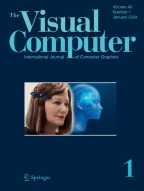260Accesses
Abstract
In the traditional gait skeleton model, the fixed length proportions among different bones cause the loss of model personality, and the shoulder and hip points that are blocked by the body are difficult to be extracted. For those problems, a method based on the spatial and temporal fusion between vision and tactility is proposed, by which a equal proportion 3D gait skeleton model can be restructured in the camera coordinate system accurately through a single-frame image. In the geometric analysis process, some logical assumptions are proposed according to human anatomy and the laws of human movement, and an effective method is proposed for the extraction of thigh slope. The experimental result shows that the consistent equal proportion models, in which single bone length error is eventually controlled within\(\pm \,5\,{\text {mm}}\), can be extracted in different position under the premise of rapidity with the aid of this method. The extracted shoulder and hip points also meet the real human body skeleton structure, which lays the foundation for the integrity and rationality of the entire skeletal model.
This is a preview of subscription content,log in via an institution to check access.
Access this article
Subscribe and save
- Get 10 units per month
- Download Article/Chapter or eBook
- 1 Unit = 1 Article or 1 Chapter
- Cancel anytime
Buy Now
Price includes VAT (Japan)
Instant access to the full article PDF.






















Similar content being viewed by others
Explore related subjects
Discover the latest articles, news and stories from top researchers in related subjects.References
Cho, C.W., Chao, W.H., Lin, S.H.: A vision-based analysis system for gait recognition in patients with Parkinsons disease. Expert. Syst. Appl.36(3), 7033–7039 (2009)
Chai, Y.M., Xia, T., Han, W.Y.: State-of-the-Art on gait recognition. Comput. Sci.39(6), 10–5 (2012)
Zhang, R., Vogler, C., Metaxas, D.: Human gait recognition at sagittal plane. Image Vis. Comput.25(3), 321–330 (2007)
Lu, H., Plataniotis, K.N., Venetsanopoulos, A.N.: A full-body layered deformable model for automatic model-based gait recognition. Eur. J. Adv. Signal Process.2008(1), 261–317 (2007)
Liu, Y.: A gait recognition method based on body skeletal model. Comput. Eng. Appl.09, 88–92 (2005)
Hamzaçebi, H., Ömer, M.: On the periodic gait stability of a multi-actuated spring-mass hopper model via partial feedback linearization. Nonlinear. Dyn.88(2), 1–20 (2017)
Sun, J., Wang, Y., Li, J., et al.: View-invariant gait recognition based on kinect skeleton feature. Multimed. Tools. Appl.2018(2), 1–27 (2018)
Wang, G.F., Wang, B., Zhong, F.: Global optimal searching for textureless 3D object tracking. Vis. Comput.31(6–8), 979–988 (2015)
Zhang, F., Zhang, X., Cao, K., et al.: Contour extraction of gait recognition based on improved GVF Snake model. Comput. Electr. Eng.38(4), 882–890 (2012)
Zhang, Y.Z., Zheng, J.M., Nadia, M.T.: Example-guided anthropometric human body modeling. Vis. Comput.31(42), 1615–1631 (2015)
Kusakunniran, W., Wu, Q., Zhang, J.: Gait recognition across various walking speeds using higher order shape configuration based on a differential composition model. IEEE Trans. Syst. Man Cybern. Syst.42(6), 1654–68 (2012)
Sigal, L., Balan, A.O., Black, M.J.: HumanEva: synchronized video and motion capture dataset and baseline algorithm for evaluation of articulated human motion. Int. J. Comput. Vis.87(1–2), 4 (2010)
Poppe, R.: Evaluating example-based pose estimation: experiments on the humaneva sets. In: Proceedings of CVPR Workshop on Ehum (2017)
Zhang, X., Ding, M., Fan, G.: Video-based human walking estimation using joint gait and pose manifolds. IEEE Trans. Circ. Syst. Video Technol.27(7), 1540–1554 (2017)
Jahangiri, E., Yuille, A.L.: Generating multiple diverse hypotheses for human 3D pose consistent with 2D joint detections[C]. In: IEEE International Conference on Computer Vision Workshop. IEEE Computer Society, pp. 805–814 (2017)
Yao, Y., Yu, Z., Sidan, D.: Learning human shape model from multiple databases with correspondence considering kinematic consensus. Vis. Comput.31(1), 19–33 (2015)
Portillo, J., Leyva, R., Sanchez, V.: A view-invariant gait recognition algorithm based on a joint-direct linear discriminant analysis. Appl. Intell.2017(13), 1–18 (2017)
Li, Q., Wang, Y., Sharf, A.: Classification of gait anomalies from kinect. Vis. Comput.2016, 1–13 (2016)
Nordin, M.J., Saadoon, A.: A survey of gait recognition based on skeleton model for human identification. Res. J. Appl. Sci. Eng. Technol.12(7), 756–763 (2016)
Acknowledgements
This work is supported by Master Innovation Funding Project Foundation of Hebei Province, P. R. China (Grant No. CXZZSS2018026), Science and Technology on Space Intelligent Control Laboratory (Grant No: ZDSYS-2017-08), State Key Laboratory of Robotics and System (HIT) (Grant No: SKLRS-2017-KF-15) and Hebei Natural Science Foundation (Grant No: F 2017202243).
Author information
Authors and Affiliations
School of Mechanical Engineering, Hebei University of Technology, Tianjin, China
Shijie Dai, Rui Wang & Huibo Zhang
Hebei Key Laboratory of Robot Perception and Human–Robot Interaction, Hebei University of Technology, Tianjin, China
Shijie Dai, Rui Wang & Huibo Zhang
- Shijie Dai
You can also search for this author inPubMed Google Scholar
- Rui Wang
You can also search for this author inPubMed Google Scholar
- Huibo Zhang
You can also search for this author inPubMed Google Scholar
Corresponding author
Correspondence toHuibo Zhang.
Ethics declarations
Conflict of interest
The authors declare that they have no conflict of interest.
Ethical approval
All procedures were performed in accordance with the ethical standards of the University of Auckland human participants and ethics approval committee (UAHPEC) and with the 1964 Helsinki Declaration and its later amendments or comparable ethical standards.
Rights and permissions
About this article
Cite this article
Dai, S., Wang, R. & Zhang, H. A gait skeleton model extraction method based on the fusion between vision and tactility.Vis Comput35, 1713–1723 (2019). https://doi.org/10.1007/s00371-018-1601-z
Published:
Issue Date:
Share this article
Anyone you share the following link with will be able to read this content:
Sorry, a shareable link is not currently available for this article.
Provided by the Springer Nature SharedIt content-sharing initiative

